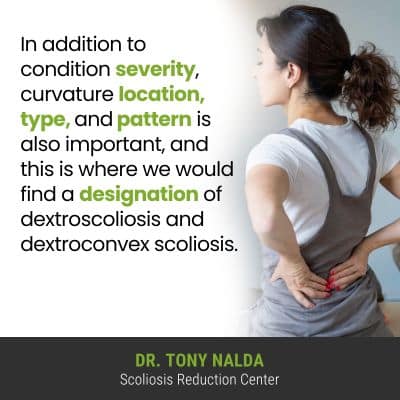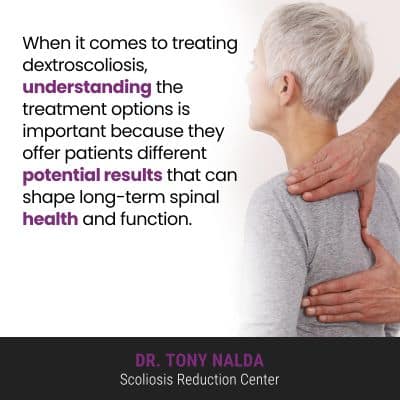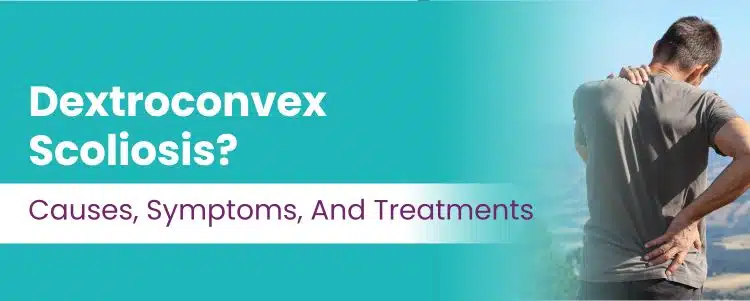There are different types of scoliosis a person can develop, and there are also different curvature types and patterns, which is why customizing treatment plans is so important. There are typical and atypical types of scoliosis, and dextroconvex scoliosis is a typical type of idiopathic scoliosis.
Dextroscoliosis refers to a typical scoliotic curve that bends to the right, away from the heart, and dextroconvex scoliosis is a further specification that the majority of the curve is rounded outwards (convex), versus concave, meaning rounded inward.
Let’s talk about some of the different variables that scoliosis is classified around: curvature location, type, and pattern being among them.
Diagnosing Scoliosis
Diagnosing scoliosis means an abnormal sideways curvature of the spine has developed, and a scoliotic spine doesn’t just bend unnaturally to the side, it also twists, making it a 3-dimensional condition.
Being diagnosed with scoliosis also means being diagnosed with a progressive and incurable condition, which is why treatment success rates are based on managing an ongoing condition for the best possible quality of life.
Scoliosis progressing means the size of the unnatural spinal curve is increasing, as are the condition’s uneven forces, and their effects, and scoliosis progression is triggered by growth.
Scoliosis is diagnosed through a physical examination that includes taking the patient’s medical and family history, performing an Adams forward bend test (the spine is the most visible when in a forward bend position), and the results of a scoliosis X-ray.
An X-ray is the only way to truly see what’s happening in and around the spine, to confirm a rotational component, and to determine a patient’s Cobb angle measurement.
Cobb Angle Measurement
A patient’s Cobb angle measurement is a key piece of information that treatment plans are shaped around.
A patient’s Cobb angle is determined during X-ray by drawing lines from the tops and bottoms of the curve’s most-tilted vertebrae; the resulting angle is expressed in degrees, and this classifies conditions based on severity.
Mild scoliosis involves the development of an unnatural spinal curve with a Cobb angle measurement of between 10 and 25 degrees.
Moderate scoliosis involves the development of unnatural spinal curves with Cobb angle measurements of between 25 and 40 degrees.
Severe scoliosis is diagnosed with Cobb angle measurements of 40+ degrees, and very-severe scoliosis curves are measured at 80+ degrees.
Condition severity tells me how far out of alignment a spine is; when the spine’s healthy and natural curves are in place, it’s vertebrae are aligned as they should be, making the spine stronger, more flexible, and better able to evenly distribute mechanical stress throughout the entire spine.

In addition to condition severity, curvature location, type, and pattern is also important, and this is where we would find a designation of dextroscoliosis and dextroconvex scoliosis.
What is Dextroscoliosis?
There are three main spinal sections, and scoliosis can develop in any one, or in more than one as a combined scoliosis:
- Cervical spine: neck
- Thoracic spine: middle/upper back
- Lumbar spine: lower back
A combined scoliosis, for example, can develop in two spinal sections such as in the upper lumbar spine and the lower thoracic spine as thoracolumbar scoliosis.
Curvature location is another classification point that treatment plans are shaped around. Not only does the curvature location tell me where to concentrate my treatment efforts, it also indicates likely symptoms of scoliosis a patient will develop.
In most cases of scoliosis, the area of the body that’s located the closest to the affected spinal section is going to feel the majority of its direct effects.
A further classification related to curvature location is curvature type, and in most typical cases of scoliosis, the unnatural spinal curve is bending to the right, away from the heart, and this is known as dextroscoliosis.
Typical cases of scoliosis have no known cause: idiopathic scoliosis accounts for approximately 80 percent of known diagnosed cases.
Atypical cases of scoliosis are associated with known causes and make up the remaining 20 percent: neuromuscular scoliosis, congenital scoliosis, and degenerative scoliosis.
In atypical cases with known causes, such as how neuromuscular scoliosis develops because of cerebral palsy, muscular dystrophy, or spina bifida, a curve bending to the left, towards the heart is common: levoscoliosis.
Congenital scoliosis is caused by a malformed spine that develops in utero, and degenerative scoliosis is caused by natural age-related spinal degeneration and the cumulative effect of certain lifestyle factors.
The most prevalent type of scoliosis overall is adolescent idiopathic scoliosis, diagnosed between the ages of 10 and 18.
Dextroconvex Scoliosis
An abnormal curvature of the spine is further classified based on whether the majority of the spinal curve bends outwards or inwards.
Convex means curved or rounded outwards, while concave means rounded inward; because of the rotational component of scoliosis making it a 3-dimensional condition, there will be portions of the spine that are convex, and some concave, but if the majority of the right-bending curve is concave, this will be diagnosed as dextroconcave scoliosis, and if the majority of the right-bending curve rounds outwards, this is diagnosed as dextroconvex scoliosis.
Dextroconvex scoliosis symptoms will vary based on a number of classification points: patient age, condition severity, type, and curvature location.
In children, the main dextroscoliosis symptoms involve postural changes caused by the condition’s uneven forces disrupting the body’s overall symmetry: uneven hips, uneven shoulders, development of a rib cage arch, uneven waistline, and disruptions to gait, balance, and coordination are also common.
In adult scoliosis, the most common symptom of dextroscoliosis is pain, and scoliosis pain can include muscle pain, back pain, and pain that radiates into the extremities (arm and leg pain) due to nerve compression.
When scoliosis develops in the lumbar region, for example, a common complication is sciatic nerve pain; the sciatic nerve starts in the lumbar spine, so if it’s unnaturally curved, the sciatic nerve within can become compressed and irritated.
Normal curvatures of the spine can cause a number of symptoms felt throughout the body; remember the brain and spine work in tandem to form the body’s central nervous system, so the spine is involved in the function of virtually every working part and system within the body.
Dextroconvex Scoliosis Treatment Options

When it comes to treating dextroscoliosis, understanding the treatment options are important because they offer patients different potential results that can shape long-term spinal health and function.
A sideways curvature of the spine that rotates is structural, so first and foremost, scoliosis has to be impacted on a structural level, and conservative chiropractic-centered treatment is what patients of the Scoliosis Reduction Center® benefit from.
Conservative treatment offers a nonsurgical alternative to traditional spinal fusion surgery; its proven results show that many cases of scoliosis don’t require surgical treatment.
With progressive conditions like scoliosis, the best time to seek treatment is always now. Scoliosis only gets more complex as it progresses, and conservative treatment is proactively started as close to the time of diagnosis as possible.
Chiropractic care is applied to work towards a curvature reduction, and physical therapy and scoliosis-specific exercise can help increase core strength, improve posture, and address any related muscular imbalance, and corrective bracing can help augment corrective treatment results by pushing the spine into a corrective position.
Rehabilitation can include continued chiropractic care and a series of custom-prescribed home exercises to help patients further heal and stabilize their spines from home.
Spinal problems need to be addressed proactively to prevent further damage and to preserve spinal health and function.
Conclusion
So what does a diagnosis of dextroconvex scoliosis mean? It means an unnatural spinal curve that bends to the right, away from the heart, has developed, and the majority of the unnatural curvature of the curve is convex, meaning it’s rounded outwards.
As cases of dextroscoliosis are typical, conservative treatment customizes treatment plans around important patient/condition variables: patient age, condition type, severity, and curvature location.
There are different types of scoliosis, along with severity levels that range from mild scoliosis to very severe scoliosis, and scoliosis symptoms tend to increase alongside progression; as progression is triggered by growth, skeletal maturity is a key factor.
Skeletal maturity is also important in terms of noticeable symptoms because as scoliosis becomes a compressive condition once skeletal maturity has been reached, this is when the spine and its surrounding muscles and nerves become vulnerable to compression.
Regardless of the type of scoliosis in question, virtually all cases are guaranteed to get worse at some point, so whether classified as idiopathic scoliosis, neuromuscular scoliosis, degenerative scoliosis, or congenital scoliosis, an abnormal curvature of the spine needs to be addressed proactively.
For adults, the best way to reduce pain caused by their scoliosis is to treat its underlying cause: the condition itself.




